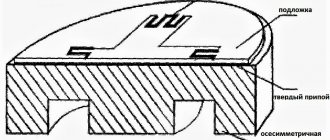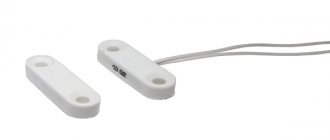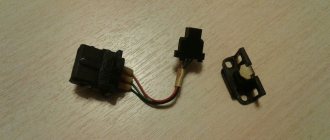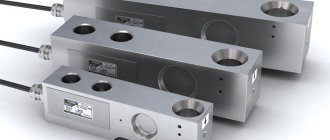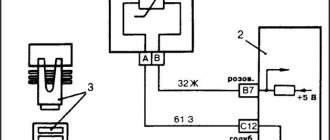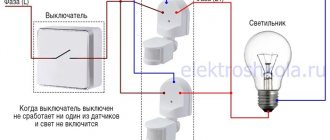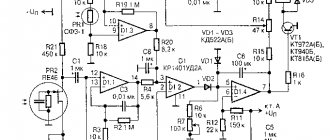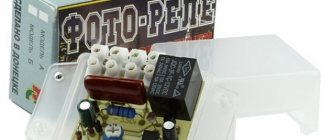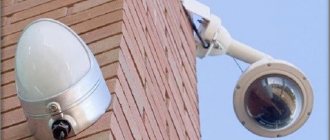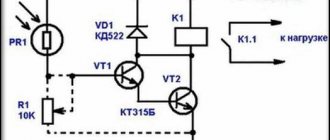Proximity sensors are used to detect objects without physical contact. There are 2-wire and 3-wire proximity sensors, and 3-wire proximity sensors are more popular. Depending on the type of output, there are two main types of proximity sensors: NPN and PNP .
Selecting the correct type of proximity sensor for a specific application can ensure that the system operates correctly. This article provides a brief description of the two main types of outputs and a guide to connecting a proximity sensor to a PLC.
Inductive sensors
In the first part of the article, possible options for sensor outputs were described. There should be no problems connecting sensors with contacts (relay output). But with transistor ones, not everything is so simple. There are many nuances that need to be taken into account: polarity, operating logic, voltage.
As an example, simplified diagrams for connecting sensors with transistor output are shown (Fig. 1) . The load is usually the controller input.
Rice. 1, a - sensor with an NPN output transistor. The common wire is switched, which in this case is the negative wire of the power source. The load (Load) is constantly connected to the “plus” (+V). Here, the active level (discrete “1”) at the sensor output is low (0V), while power is supplied to the load through the opened transistor.
Rice. 1, b - case with a PNP transistor at the output. The load (Load) is constantly connected to “minus” (0V), the supply of discrete “1” (+V) is switched by a transistor. This case is the most common, since in modern electronics it is common to make the negative wire of the power supply common (zero), and activate the inputs of controllers and other recording devices with a positive potential.
The transistor output voltage is typically determined by the supply voltage, which is usually limited within a narrow range. For example, from 18 to 30 V. You can look at this from the other side - now most devices are standardized by voltage.
Next, we move from theory to practical issues.
Attention! For convenience, the terminal designations are shown in the vertical position of the device
- Input for digital temperature sensors (solid wire from the sensor).
- Discrete input No. 1 – allows you to connect the emergency output of various equipment.
- Discrete input No. 2 – allows you to connect the emergency output of various equipment.
- Output #1 +5 VDC.
- Output #2 +5 VDC.
- Output No. 4 – NC contact of relay output (220 V 200 W).
- Output No. 4 – Main relay contact.
- Output No. 4 – NO relay output contact (220 V 200 W).
- Output #3 +12 VDC.
- Common “-” (wire with a strip from the sensor).
Sensor interchangeability
As I already wrote in the previous part of the article, there are four types of sensors with transistor output, which are divided according to the internal structure and switching circuit: PNP NO; PNP NC; NPN NO; NPN NC.
It happens that the required type of sensor is not at hand, but the equipment must work without downtime! The good news is that the listed types of sensors can be replaced with each other.
This is implemented in the following ways:
- Alteration of the initiation device - the design is mechanically changed. For example, if the NO sensor reacted to the presence of metal, then the NC sensor will react to its absence. If the output is of the same polarity, then neither the program nor the operating algorithm will change.
- Changing the existing sensor switching circuit (we will consider it in more detail below).
- Switching the type of sensor output (if there are such switches on the sensor body).
- Reprogramming the controller program (changing the active input level, changing the program algorithm).
Naturally, manufacturers are silent about such opportunities in order to sell a large number and range of products. Below is an example of how you can replace a PNP sensor with an NPN one by changing the connection diagram (Fig. 2) .
Understanding the operation of these circuits will help you understand the fact that the transistor is a key element that can be represented by ordinary relay contacts.
In Fig. 2, a shows a diagram of a sensor with a normally open PNP type output. When the sensor is not active, its output "contacts" are open and no current flows through them. Conversely, if the contacts are closed, then the flowing current creates a voltage drop across the load.
When activated, voltage (+V) is supplied to the controller input through an open transistor, and it is activated. How can we achieve the same with NPN output?
We look at the changes in the circuit in Fig. 2, b . First of all, the operating mode of the sensor output transistor is ensured. To do this, an additional resistor is added to the circuit; its resistance is usually about 4.7–10 kOhm. Now, when the sensor is not active, voltage (+V) is supplied to the controller input through an additional resistor, and the controller input is activated.
Areas of use
The possible area of application of induction sensors is so wide that it allows them to be used not only in everyday life and the automotive industry, but also in industry with robotics, as well as medicine.
Medical devices
Inductive sensors are widely used in the production of medical equipment, since the magnetic properties of the device make it possible to record pulmonary ventilation, vibration parameters, and also take ballistocardiograms.
Appliances
In everyday life, sensors can act as a device for monitoring water supply, lighting level and door position (closed or open), therefore they are used in the production of, for example, washing machines and other household appliances. In addition, the devices are used in the process of creating smart home elements.
Automotive industry
An induction sensor is also used in the automotive industry, acting as a controller that determines the position of the crankshaft. When a metal object, in this case a gear tooth, approaches the device, the magnetic field generated by the built-in permanent magnet increases, which leads to the induction of an alternating voltage in the coil.
Attention! Some manufacturers are trying to change the design of the induction sensor to increase efficiency, for example, using external magnets to activate it
Robotic equipment
In the case of robotics, inductive sensors have found application in the production of unmanned vehicles and industrial robots to increase their sensitivity to obstacles and the ability to recognize objects, as well as devices for which self-balancing is important.
Industrial control and measurement technology
They are widely used in the operation of conveyor systems, packaging machines and assembly lines, as well as as part of all types of machine tools and shut-off valves. Inductive sensors also help to monitor small and large elements of industrial equipment (gear teeth, steel flags, stamps), production objects (metal products, metal sheets, covers), etc. In addition, when connected to pulse counters, the result is a rudimentary but extremely effective reading device.
How to repair and check an inductive sensor?
Proximity sensors are practically not subject to repair, since they have a solid body filled with a compound. In addition, most breakdowns are associated with mechanical damage due to careless personnel or shifting of the activator.
To test the sensor electrically, you need to supply power to it, that is, connect it to the circuit, and then activate (initiate). When activated, the indicator should light up. But the indication does not guarantee the correct operation of the inductive sensor. You need to connect the load and measure the voltage across it to be 100% sure.
Color coding of sensor leads
There is a standard sensor labeling system. All manufacturers currently adhere to it.
- Blue - minus power.
- Brown – plus nutrition.
- Black - exit.
- White – second output, or control input.
However, immediately before installation, it would be useful to make sure that the connection is correct by referring to the connection manual (instructions). In addition, as a rule, the wire colors are indicated on the sensor itself, if its size allows.
Specific manufacturers
Below is my subjective opinion on the sensors that I had to deal with.
"TEKO". For those who choose a domestic manufacturer. This Chelyabinsk company has been around since Soviet times and currently produces a wide variety of sensors. Unfortunately, in my experience, they account for a large number of electrical failures. They also have weak mechanical strength. I hope the company has now improved the quality of its products. The undoubted advantage of this company is the price, which can be 2-3 times lower than imported analogues (with the exception of China). An example of the use of an inductive sensor "Teko" - fig. 4 .
Rice. 4 - Example of using an inductive sensor “TEKO”
In this case, the activator, which passes by the sensor, has moved and broken the original sensor. The solution was to install a Teko sensor with a large response zone.
AUTONICS . The optimal choice in terms of price/quality ratio. This Korean company produces a large number of sensors with good quality. Thanks to modest investments in brand promotion, prices remain very reasonable.
In Fig. Figure 5 shows an example of modernizing the soldering head of a packaging line.
Rice. 5 — An example of upgrading the soldering head of a packaging line
At the top is the Autonics sensor. Previously, an electric limit switch was installed, as in the lower part of the photo. To eliminate problems with contacts, it was decided to install an inductive sensor, which Autonics did an excellent job with and the failures stopped. The completion was the laying of an additional power wire and the manufacture of a mounting plate.
OMRON . This is an old, well-promoted brand, so the price for these sensors is quite high. However, the quality is up to par.
In Fig. 6 - sensors show the position of the gearbox mechanism.
Rice. 6 - The sensor shows the position of the mechanical gearbox.
In most cases, installing sensors from popular brands is impractical, so they are installed in equipment of a high price category.
ALLEN BRADLEY . This American brand is like the Rolls-Royce in the world of engines. The price is very high, but the quality in this particular case let us down: the sensor installed on the lid of the bulk solids bin stopped working (Fig. 7) .
Rice. 7 — Allen Bradley transmitter
It turned out that the problem was in the connector contacts. They were bent and cleaned. In this case, with proper installation, the Teko sensor would do a great job. By the way, the difference in price of these sensors is about 10 times!
It should be said that currently more than 90% of the total number of inductive sensors are replaced by sensors from other manufacturers. There are rarely times when a specific type is needed. As a rule, this is due to the dimensions and installation features. Within one enterprise, it is advisable to choose one manufacturer.
This article is the second part of an article about the types and principles of operation of sensors. For those who haven’t read it, I recommend it, there are a lot of subtleties laid out on the shelves.
KERUI KR-G18 - instructions for setting up a GSM alarm.
Good afternoon I recently reviewed the KERUI KR-G18 alarm system - KERUI KR-G18 GSM alarm system. Russian firmware. I bought the alarm itself here - KERUI official store. In that review, I promised to review the menu and also show how to configure the KERUI KR-G18. I keep my promise. Although I’ll say right away that this instruction is not a complete overview of all GSM alarm capabilities. The alarm system is already configured and working, so I didn’t risk conducting experiments on it. But I am sure that the instructions I wrote will be sufficient in 90% of cases. I also apologize in advance for the quality of the photos. I photographed the already installed alarm system.
Before setting up, let's understand the control keys and remote control:
Control keys in menu mode:
Let's start setting up KERUI KR-G18:
Step 1
Everything on the screen is quite informative: time, date, day of the week, GSM signal level, battery charging status, alarm status (disarmed).
Step 2
Press the menu entry key and get to the main menu:
On the KERUI G18 alarm screen we see eight main menu items: 1. Setting dial-up numbers. Used to set numbers for calling and sending SMS. 2. Connecting sensors and key fobs. Here we establish a connection between the alarm system and sensors, key fobs, sirens, and special devices. 3. Settings. Setting volume, response delay, siren settings, display, schedule settings... 4. Recording voice messages. 5. Setting up security zones. We configure how and when our sensors will be triggered, and to which numbers warnings will be sent. 6. Setting date and time. 7. Event log. 8. Device information. Shows the GSM alarm firmware version.
Step 3
Go to the menu item “Setting dial-up numbers” and press the confirm button:
Select the item “Number for SMS” Press the number 1 (for the first number) -> confirm -> dial the number to send SMS -> confirm. If necessary, we program other numbers. Programming dial-up numbers. Select the item “Number to call”. Press the number 1 (for the first number) -> confirm -> dial the number to call -> confirm. If necessary, program 5 more numbers in the “Voice” menu item. call" we can check the operation of the SIM card - call any phone number.
Step 4
Go to the menu item “Connecting sensors and key fobs” (Additional accessories) and press the confirm button:
First we register the key fobs. Go to the “Register” menu item. key fob" -> click confirm -> Enter the serial number of the key fob -> Click confirm -> Press any button on the key fob. Repeat for all keychains. Then we register the sensors. Go to the “Register” menu item. sensor" -> click confirm -> Enter the number of the zone to which the sensor will be assigned -> Click confirm -> make the sensor work. Repeat for all sensors. It is advisable to write down which zone each sensor is connected to.
Step 5. Setting up security zones.
Go to the menu item “Setting up security zones” and press the confirm button:
Previously, we linked each sensor to its own zones. There can be 99 zones in total. Now let’s configure each zone. As you can see in the photo below, we can turn off the siren and set which numbers will receive an alarm from this zone. Let’s take a special look at the “Type” setting.
The KERUI KR-G18 GSM alarm system has seven trigger types. From the factory they are configured like this:
- Normal - 01-59 zones
- Partial - 60-79 zones
- Intelligence - 80-89 zones
- Help for the elderly -90 zones
- Gong - 91 zones
- Greeting - 92 zones
- Alarm - zones 93-99
Connection diagrams for PNP and NPN sensors
The difference between PNP and NPN sensors is that they switch different poles of the power source. PNP (from the word “Positive”) switches the positive output of the power supply, NPN – negative.
Below, as an example, are diagrams for connecting sensors with a transistor output. Load – as a rule, this is the controller input.
PNP sensor output. The load (Load) is constantly connected to “minus” (0V), the supply of discrete “1” (+V) is switched by a transistor. NO or NC sensor – depends on the control circuit (Main circuit)
NPN sensor output. The load (Load) is constantly connected to the “plus” (+V). Here, the active level (discrete “1”) at the sensor output is low (0V), while the load is supplied with power through the opened transistor.
I urge everyone not to get confused; the operation of these schemes will be described in detail below.
The diagrams below show basically the same thing. Emphasis is placed on the differences in the PNP and NPN output circuits.
Connection diagrams for NPN and PNP sensor outputs
The left figure shows a sensor with an NPN . The common wire is switched, which in this case is the negative wire of the power source.
On the right is the case with a PNP at the output. This case is the most common, since in modern electronics it is customary to make the negative wire of the power supply common, and activate the inputs of controllers and other recording devices with a positive potential.
The main differences between the two types of bipolar transistors
The main difference between them is that holes are the main current carriers for PNP transistors, NPN transistors have electrons in this capacity. Therefore, the polarities of the voltages supplying the transistor are reversed, and its input current flows from the base. In contrast, with an NPN transistor, the base current flows into it, as shown below in the circuit diagram for connecting both types of devices with a common base and a common emitter.
The operating principle of a PNP-type transistor is based on the use of a small (like the NPN-type) base current and a negative (unlike the NPN-type) base bias voltage to control a much larger emitter-collector current. In other words, for a PNP transistor, the emitter is more positive with respect to the base and also with respect to the collector.
Replacing sensors
As I already wrote, there are fundamentally 4 types of sensors with transistor output, which are divided according to the internal structure and switching circuit:
All these types of sensors can be replaced with each other, i.e. they are interchangeable.
This is implemented in the following ways:
- Alteration of the initiation device - the design is mechanically changed.
- Changing the existing sensor connection circuit.
- Switching the type of sensor output (if there are such switches on the sensor body).
- Program reprogramming – changing the active level of a given input, changing the program algorithm.
Below is an example of how you can replace a PNP sensor with an NPN one by changing the connection diagram:
PNP-NPN interchangeability schemes. On the left is the original diagram, on the right is the modified one.
Understanding the operation of these circuits will help you understand the fact that the transistor is a key element that can be represented by ordinary relay contacts (examples are below in the notation).
What's new in the VK SamElectric.ru group?
Subscribe and read the article further:
So, the diagram is on the left. Let's assume that the sensor type is NO. Then (regardless of the type of transistor at the output), when the sensor is not active, its output “contacts” are open and no current flows through them. When the sensor is active, the contacts are closed, with all the ensuing consequences. More precisely, with current flowing through these contacts)). The current flowing creates a voltage drop across the load.
The internal load is shown with a dotted line for a reason. This resistor exists, but its presence does not guarantee stable operation of the sensor; the sensor must be connected to the controller input or other load. The resistance of this input is the main load.
If there is no internal load in the sensor, and the collector “hangs in the air,” then this is called an “open collector circuit.” This circuit ONLY works with a connected load.
So, in a circuit with a PNP output, when activated, voltage (+V) is supplied to the controller input through an open transistor, and it is activated. How can we achieve the same with NPN output?
There are situations when the required sensor is not at hand, and the machine must work “right now”.
We look at the changes in the diagram on the right. First of all, the operating mode of the sensor output transistor is ensured. To do this, an additional resistor is added to the circuit; its resistance is usually about 5.1 - 10 kOhm. Now, when the sensor is not active, voltage (+V) is supplied to the controller input through an additional resistor, and the controller input is activated. When the sensor is active, there is a discrete “0” at the controller input, since the controller input is shunted by an open NPN transistor, and almost all of the additional resistor current passes through this transistor.
Bipolar transistor device
https://youtube.com/watch?v=iqraL2VcOjw
The element was called bipolar because two types of charge carriers take part in its operation: electrons (stable negatively charged elementary particles) and holes (quasiparticles with a positive charge). The operation of a previously developed unipolar (field) device is based on the use of only one of the media. The device has 3 layers, each of which is supplied with voltage:
- emitter;
- base (base plate, plate);
- collector.
Negative is a silicon alloy. It has an excess of negative charge carriers - electrons (n-doped), and positive - an excess of positive “holes” (p-doped).
The base is very thin, represented by a lightly doped semiconductor, so it has strong resistance. The collector is usually wider than the emitter. Therefore, the total area of the base-collector connection is significantly larger than the base-emitter complex. These 2 areas cannot be swapped by changing the polarity. The transistor is not a symmetrical element - this is necessary for its proper operation.
Color coding of sensor leads
There is a standard sensor labeling system. All manufacturers currently adhere to it.
However, before installation, it is a good idea to make sure that the connection is correct by referring to the connection manual (instructions). In addition, as a rule, the wire colors are indicated on the sensor itself, if its size allows.
This is the marking.
- Blue – Minus power
- Brown – Plus
- Black – Output
- White – second output, or control input, see the instructions.
Real sensors
It is problematic to buy sensors, the product is specific, and electricians do not sell these in stores. Alternatively, you can buy them in China, on AliExpress.
Here are the types of optical sensors I encounter in my work.
Thank you all for your attention, I look forward to questions about connecting sensors in the comments!
Option No. 1: use a special converter, for example a USM signal matching device, which is presented in our assortment, or a similar one.
Option No. 2: if you are at least minimally comfortable with a soldering iron, make the converter yourself.
If you have a sensor with a PNP output, but you need NPN, we assemble the following circuit:
Transistor Q1 is any suitable NPN, for example 2SC495, BC445, BD237.
If you have a sensor with an NPN output, but you need a PNP, use the following circuit:
Transistor Q1 - any suitable PNP, for example 2N5401, KT502D.
